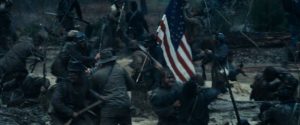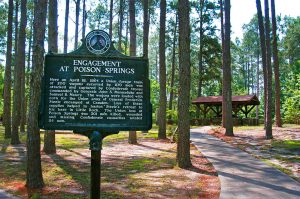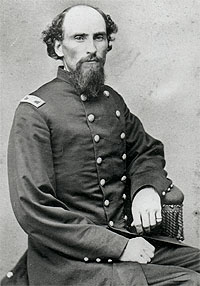Remember Poison Spring!
 If you have seen the 2012 film Lincoln, you may remember the first two scenes: a gruesome hand-to-hand fight between white Confederate troops and African-American Federal soldiers, and two USCTs speaking with their commander-in-chief. Besides the overarching themes of race, both scenes discuss an important battle for both the Trans-Mississippi Theater and for the story of African-American involvement in the war. As Lincoln would say in the scene, referring to one of the USCTs, “Second Kansas Colored Infantry, they fought bravely at Jenkins’ Ferry.”
If you have seen the 2012 film Lincoln, you may remember the first two scenes: a gruesome hand-to-hand fight between white Confederate troops and African-American Federal soldiers, and two USCTs speaking with their commander-in-chief. Besides the overarching themes of race, both scenes discuss an important battle for both the Trans-Mississippi Theater and for the story of African-American involvement in the war. As Lincoln would say in the scene, referring to one of the USCTs, “Second Kansas Colored Infantry, they fought bravely at Jenkins’ Ferry.”

Indeed, the Kansas troops did. The victory there for the African-American troops was for a much more important, emotional cause than simply preserving the Union and establishing Federal control in Louisiana and Arkansas. In fact, the Second Kansas Colored Infantry had sought revenge for what had happened to their fellow colored troops in the First Kansas Colored Infantry at another battle in Arkansas – the Battle of Poison Spring.

These Kansas regiments were two of the pioneering all African-American combat units. Spearheaded by abolitionist Jim Lane and commanded by Colonel James M. Williams, the First Kansas was the very first of its kind raised for service in the Union Army and was the first colored regiment to fight against Confederate troops in combat at the Battle of Island Mound (Bates County, Missouri) in October 1862.
Due to the high demand and the performance of the First Kansas in combat, the Second Kansas was organized one year after in August 1863. Under the command of prominent Kansas Republican Samuel J. Crawford, these men were tough fighters, who were committed to freedom, equality, and Union. Like the First Kansas, many were former slaves from Missouri and Arkansas, who fled to free territory in Kansas, or were devoted abolitionist freemen. They would be engaged in their first fight just two months after mustering – the brutal massacre at Baxter Springs.
By April 1864, the two units were attached to the VII Corps in Brigadier General John Milton Thayer’s Frontier Division, as part of the larger Union effort to seize northern and eastern Texas, as well as much of the Red River Valley in Louisiana. This multi-pronged offensive, named the Red River Campaign, would hopefully, in the eyes of the War Department, establish Federal control over Texas, Arkansas, and Louisiana.
One of those prongs was spearheaded by Major General Frederick Steele, in command of the VII Corps, who, with Major General Nathaniel Banks, aimed to take Shreveport, Louisiana. Following several early campaign victories, Steele’s army resupplied at Camden, Arkansas on April 15. Steele soon ordered a detachment roughly twenty miles north to fetch a large Confederate supply of corn. Under the command of Colonel James Williams, the 600-man force, accompanied by 198 wagons, included the First Kansas Colored Infantry. On April 18, Williams’ men began their journey back toward Camden until they were attacked by Brigadier General John S. Marmaduke’s cavalry brigade of 3,600 Rebel troopers and twelve guns.

Though they held back two assaults by Marmaduke’s men, a final third assault broke the Union lines, specifically where the First Kansas Colored Infantry was positioned. This breakthrough forced the entire Federal force to fall back, with the Rebel cavalry in close pursuit. However, for the wounded and captured colored troops, Marmaduke’s men – particularly the Choctaw, who wanted revenge for lost tribal land – showed no mercy.
Colonel Williams, though he did not witness the massacre, wrote, “Many wounded men belonging to the First Kansas Colored Volunteers fell into the hands of the enemy, and I have the most positive assurances from eye-witnesses that they were murdered on the spot … the gallant dead, officers and men, all evinced the most heroic spirit, and died the death of true soldiers.”[1] A combination of race and revenge (particularly for the Choctaw soldiers) were causes of this violent massacre against the colored troops. Over three hundred men were lost, along with captured 198 wagons, at Poison Spring.
The defeat at Poison Spring forced Steele to fall back across the Ouachita River out of fear of being surrounded at Camden. Luckily for Steele, the heavy rains and swollen rivers slowed Price’s men enough for the Federals to get further ahead. On April 29, Steele’s column arrived at the flooded Saline River and were prepared to cross the river at Jenkins’ Ferry. However, due to the swollen river and the flooded plain, the Federals were forced to defend the crossing and dig in.
In the evening of April 29, Marmaduke’s cavalry met Steele’s rear guard, just two miles from the ferry. By daylight, the fight resumed and pressure continued to build on the Federal rear guard. In support of the Union rear guard came the troops of the Second Kansas Colored Infantry along with the rest of the division. They held their position for roughly two hours.

However, when the Confederates moved a three-gun battery towards the Second Kansas’ front, Colonel Crawford order his men to charge with fixed bayonets. “I ordered my regiment fix bayonets and charge the battery, which order was executed promptly and with a coolness and courage worthy of veterans, the regiment steadily advancing, with continuous and hearty cheering, under a galling fire of musketry and artillery,” recalled Crawford. For the first time since the massacre of the First Kansas at Poison Springs, the Second Kansas troops were able to get their revenge
Reportedly, the Second Kansas men were shouting, “Remember Poison Spring!,” as they stormed the battery, bayoneting many of the Rebels there. “I have not seen, in the many conflicts I have witnessed during this war,” Crawford reflected, “troops who displayed a greater degree of coolness, courage, and daring than was displayed by the colored troops under my command during the battle of Jenkins’ Ferry.”[2]
A fellow veteran commended the Second Kansas’ actions at the battle, “Our Colored Troops fought bravely. They never took prisoners. The enemy do not show them any quarters. So they do the same.”[3] Newspapers across the country reported on the Second Kansas’ bravery at Jenkins’ Ferry, saying, “The 2d colored were charged three times, by the Rebels, the fourth charge they made themselves, drove back the enemy and took a section of a battery, consequently, ‘perfectly covered themselves with glory.’”[4] At Jenkins’ Ferry, the Second Kansas not only made their revenge, but, most importantly, they proved that “negroes would fight,” which helped set the precedent for African-American military service.[5]
Between the Battles of Poison Spring and Jenkins’ Ferry, the First and Second Kansas Colored Infantry Regiments proved themselves on the battlefield, not only as pioneering combat units, but also as formidable fighters. Though both units were some of the very first of their kind formed in United States military history, they have been much overlooked in the larger narrative of African-American service in the Civil War in comparison to the more famous units, such as the 54th Massachusetts. Though serving in smaller and lesser-known battles in the Trans-Mississippi, they nonetheless showed the world they could fight just as well as any other soldier. For this Black History Month, we honor the men of the First and Second Kansas, who had their baptisms of fire at Poison Spring and Jenkins’ Ferry.
Sources:
[1] Report of Col. James M. Williams, First Kansas Colored Infantry, Commanding Detachment Frontier Division, of Engagement at Poison Spring, April 24, 1864, in The War of the Rebellion: The Official Records of the Union and Confederate Armies, ser. 1, vol. 34, part 1 (Washington, DC: Government Printing Office, 1891), 743.
[2] Report of Colonel Samuel J. Crawford, Second Kansas Colored Infantry, of Engagement at Jenkins’ Ferry, OR, ser. 1, vol. 34, part 1 (Washington, DC: Government Printing Office, 1891), 757.
[3] Letter from Henry Strong to Cousin Otis, May 6, 1864, Topeka, KS: Kansas Historical Society.
[4] “Interesting Letter from Fort Smith,” The Union Crusader (Paola, KS), June 17, 1864.
[5] C.R. Stuckslager, “From the Twelfth Kansas: Interesting Letter from Surgeon Stuckslager,” The Leavenworth Daily Conservative (Leavenworth, KS), August 25, 1864.
Excellent!
Being from New Orleans, I am particularly interested in the Choctaw. Will you write more about them in the future?
Thanks, Sean! I hope to do more research on them and the role of Native Americans in the Trans-Miss.
Frederick Steele is also an interesting and quite neglected story. A West Pointer and classmate of Grant and Sherman, he served in the Mexican War and later in California in the run up to statehood. After the failed Camden Expedition he redeemed himself by leading the Column from Pensacola, which included nine USCT regiments, in the assault on Fort Blakely in April 1865.
Too often the war, as well as modern discussions, are reduced to a two race template. The actions of the native troops at Poison Springs refute this simplistic evaluation.
My 2nd great grandfather, Cpl Robert Bland was with the 1st Kansas and was wounded in this battle at Poison Spring. I find this story of this battle very interesting. His enlistment records show him enlisting in Jan 13, 1863 and his company Muster roll for March/April 1864 says he was wounded at Poison Springs 18 Apr 64.. He stayed the duration and was mustered out on 01 Oct 1865. Thank you.